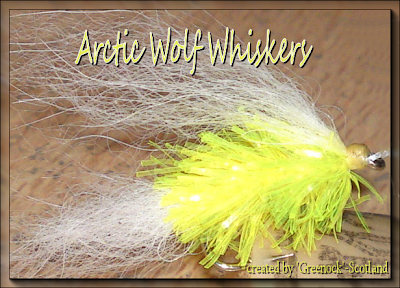3rd Sept.,2010
Hi there... a few of the tiers that I had asked to try out Nantuc's fur have come through at last...so here we go a tour of what has transpired..
..from North Ireland the tier is..GBigtrout
..these two flies are fished as 'drys'..
..the first is the Palmered Wolf :
...This fly has more than proven itself with the taking of both the Browns and the Rainbows that this tier created it for. To date, he has caught and released over 100 trout in a 3 week period of fishing, from 6" to four pounds. I have only posted two pics of his fish, showing the flies buried in their mouth, these fish represents the total of both flies.
..the second is the Sedge Wolf :
...this concludes the two flies that my good friend GBigtrout made with Nantuc's fur, however, I'm certain that he will come up with more as time passes by, for this gentleman from the north ties in the manner of a professional commercial tier, ending with the tiniest heads I've ever seen..mind you all in the UK strive for that perfect 'little' head. Now to post a couple of his fish, so everyone can see...
..the next tier is from South Ireland, the tier is Seanie
..his flies are called ..The Arctic Moth...
..and the second fly is ..Polar Wolf...
..Seanie lives in the south western part of Ireland, and he fishes for browns and Atlantic Salmon and Sea-trout, here are a few photos of the areas he fishes, with a nice catch of salmon..
The next tier is from Vancouver Island,BC,the tier is Troutman Clay
..this fly is called ..The Wolf Poacher...
..This fly was created with the sole purpose of attracting anyone of the 5 species of Salmon found in the Pacific Ocean, that spawns in the rivers of the western coastline of the province of British Columbia, Canada. To date it has captured 'Pink Salmon', 'Coho Salmon', yet to be tested on the 'King [Chinook or Tye] Salmon, 'Chum Salmon' or the 'Sockeye Salmon'..
..Troutman Clay..resides on the Island and has spent his time fishing for the Salmon as well as the Trout and Steelheads that inhabit Vancouver Island,BC,Canada. Sometime this coming fall/winter, he has told me that he will try using this fly for the 'steelies', when they arrive. Do to a mishap with his camera, he was unable to take any fish porn that his fly caught..however..he was kind enough to present a few pics of the waters where he was fishing...
..this is the estuary of the Cluxewe River, with other photos to follow..
..photos showing the beach front close to the estuary..and this last photo was a special treat, showing of a hump whale..
..this next fly was produced in Scotland, by the tier Greenock..
..the fly is called 'Arctic Wolf Whiskers'..
............................................................................................
............................................................................................
I have been fortunate to find a local source for "Alpaca Prime Fiber", in natural colours...i.e.:
White [natural shades of off white], Browns [which consists of red high lights and various shades], Black and Gray. These colours can be dyed to whatever colours you desire.
This is a super soft fiber which reacts to the currant motion of the water, be it a stream, river, or still water, fish can not resist!
Alpaca Information
Grading
This picture shows where the fiber that we use to create our flies comes from using just '1st Prime Fiber' and '3rd Class Fiber'. Please note that the 'micro count' on the fleece is quite high at 17. This pertains to ALL parts of the animal's fleece. A fleece is labeled 1st, 2nd, and 3rd according to where the fleece is sheared from, as shown. The 'Prime [1st] Fiber' comes from the neck and belly area, the 2nd fiber comes from the hips or haunches area, the 3rd fiber comes from the lower leg area.Cleaning/Preparation
1. Boil water to start.2. Add the fiber to HOT WATER, not boiling, so allow the water to stop boiling.
3. Add dish soap such as Sunlight to the water.
4. Place the amount of fiber you want into the water DO NOT SWISH IT AROUND it will bind up and make clumps if you do because this is what it does naturally, just put it into real hot water.
5. Let the fiber soak for a bit. You will see the dirt pour out of it [at this point you will see things like bits of straw, twigs etc.,rather common to find in the fiber cause the animal lays around..just pull them out AFTER it is dried with tweezers].
6. After a bit, which you can judge, take the fiber out, again, DO NOT SWISH IT AROUND just lay it out on paper towel to air dry or drape it over a line to air dry as well.
The fiber drys rather quickly - 30 minutes or so. If you have a wire brush for combing pets, at this point you can "comb" it out to pull apart the amount, you will see how bright White it has become or how bright whatever colour you are washing, plus you will notice how soft it has become as well. If you wish dye it to the colour you want. Remember White is best for dying.
Colour Chart
The leg fiber is ideal for making 'Leech' patterns...
The Prime fiber can be used for dubbing of various flies, being that it extremely soft and has a translucent shine to it .
Here is a fly using alpaca prime dubbing.. dyed of course,including marabou feathers.
Alpaca Leg Fiber: one full weighed ounce of material for only $10 plus shipping.
Alpaca Prime Fiber: one full weighed ounce of material for only $15 plus shipping.
To order please refer to this site......
http://www.go-wyld.ca
or..contact me personally.. coastalwolf@gmail.com ..



























